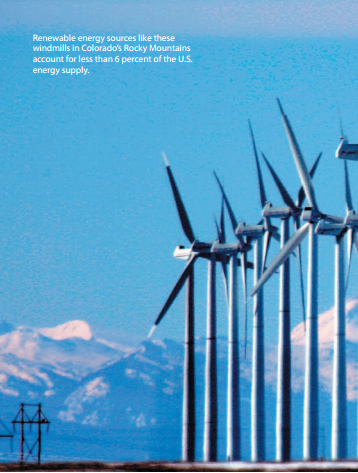
All that Energy
American.gov | 2013-01-24 14:27

Renewable energy sources like these windmills account for under 6 percent of the U.S. energy supply. (© AP Images/Ed Andrieski)
High production requires energy; can the U.S. do more with less?
(The following article is taken from the U.S. Department of State publication, USA Economy in Brief.)
The U.S. economy uses a lot of energy – in 2005, 99.89 quadrillion British thermal units (Btu). Nearly all of the energy produced in the United States is consumed within country, and then the United States imports a lot more.
"Fossil fuels – coal, oil, and natural gas – currently provide more than 85 percent of all the energy consumed in the United States, nearly two-thirds of our electricity, and virtually all of our transportation fuels," reports the U.S. Department of Energy.
The department predicts that U.S. reliance on fossil fuels will continue increasing for decades, “even with aggressive development and deployment of new renewable and nuclear technologies.”
Less than 8 percent of the U.S. energy supply comes from nuclear energy and less than 6 percent from renewable energy, mostly hydroelectric and biomass.
Energy is costing more money around the world as demand rises, especially in rapidly expanding economies such as China and India. At the same time, energy supplies, notably petroleum, fall increasingly under the control of state-owned companies outside the major economies.

Oil refineries like this one in Texas process the 20.6 million barrels the U.S. economy uses each day. (© AP Images/David J. Phillip)
Nearly one-third of the U.S. energy supply is imported, as is nearly two-thirds of its petroleum. In 2006 the U.S. economy used, on average, 20.6 million barrels of petroleum a day, nearly one-fourth of the world supply. U.S. dependence on foreign oil has become a major political issue.
“Since there are few readily available substitutes for oil, even a relatively minor disruption of the global oil supply has the potential to cause economic dislocation for tens of millions of Americans,” a report from the Energy Security Leadership Council says.
TConserving energy through better efficiency and developing energy supplies other than fossil fuels are U.S. policy goals, but getting to a political consensus about achieving those goals is tough.
The U.S. economy has already accomplished some energy efficiency. It now uses only half as much oil to produce an (inflation-adjusted) dollar of GDP as it did at the time of the 1970s oil price shocks. The reasons? Expanding sectors of the economy that rely less on energy, raising auto fuel efficiency standards, and slashing use of oil for electric power.
Even so, as of 2004, U.S. energy efficiency still ranked behind that in other major economies except Canada.
A 2005 energy law passed by Congress provides many different incentives, such as loan guarantees, tax breaks, and subsidies for energy industries (including nuclear, biomass such as ethanol, and fossil fuels). Cleaner-burning coal is a major objective – the United States has big supplies of coal. The law also provides limited tax breaks for home improvements for energy efficiency and for purchases of energy-efficient motor vehicles.
For environmental as well as economic reasons, some state governments, especially California's, have gone further than the federal government in raising energy efficiency standards for housing, businesses, and motor vehicles.
Still, federal, state, and local governments are wrangling over how to accomplish much more to bolster energy security.
Does foreign investment also pose a problem for the U.S. economy?
Share this page



















